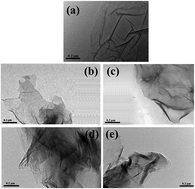The effect of doped heteroatoms (nitrogen, boron, phosphorus) on inhibition thermal oxidation of reduced graphene oxide
Abstract
The doping of nitrogen into reduced graphene oxide (NRGO) is achieved by reduction of graphene oxide with hydrazine hydrate and ammonium hydroxide. Boron (BRGO) or phosphorus (PRGO) doped reduced graphene oxide (RGO) is obtained by annealing of RGO (prepared by reduction with sodium borohydride) with boric acid or phosphoric acid, respectively. The successful preparation of the doped RGO is confirmed by Fourier transform infrared spectroscopy, X-ray diffraction, Raman spectroscopy, X-ray photoelectron spectroscopy and transmission electron microscopy. A remarkable enhancement in thermal oxidative stability of RGO is achieved by doping of these heteroatoms. The enthalpy values of BRGO and PRGO during the thermal oxidation decrease remarkably compared with that of RGO, indicating the reduced heat release by the doped heteroatoms. The mechanism for improvement in thermal oxidative resistance by doping of heteroatoms is demonstrated clearly. Doping of boron atom not only lowers the electrons density on the reactive carbon atoms and the Fermi level of carbon, but also contribute to graphitization of RGO, leading to inhibition of thermal oxidation of RGO. Phosphorus containing complexes, in the forms of metaphosphates, C–O–PO3 and C–PO3 groups, can poison the active sites on RGO and function as physical barrier for the access of oxygen. Retarding oxidation of RGO against air may be strengthened by forming more thermostable structure in NRGO, for example: pyrrolic-N (NC2), pyridinic-N (NC2) and graphitic-N (NC3). The doping of heteroatoms will provide an important strategy for broadening RGO application at the elevated temperature.


 Please wait while we load your content...
Please wait while we load your content...